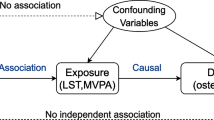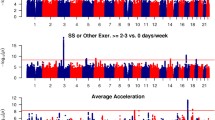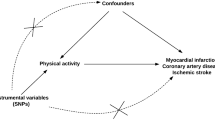Abstract
Background
Physical activity (PA) is considered to play an important role in the reduced gout risk. However, the epidemiology results are inconsistent and causality remains unclear.
Objective
To investigate the causal relationship of PA with serum urate concentrations and gout risk by a bidirectional Mendelian randomization (MR) approach.
Method
Two genome-wide association studies (GWASs) from UK Biobank were used to identify instrumental variables for self-reported moderate-to-vigorous PA (including 377,234 European individuals), accelerometer-measured ‘average acceleration’ PA (including 91,084 European individuals) and accelerometer-measured overall PA (including 91,105 European individuals). The summary data for serum urate (including 110,347 European individuals) and gout (including 2,115 cases and 67,259 controls) were derived from GWAS of Global Urate Genetics Consortium. Moreover, reverse direction Mendelian randomization study was conducted. The inverse-variance weighted, weighted median, Mendelian randomization Egger regression, simple mode and weighted mode and Mendelian Randomization Pleiotropy RESidual Sum and Outlier were methods we performed.
Result
Genetic predisposition to accelerometer-measured ‘average acceleration’ PA [beta = -0.038; 95% confidence interval (CI) = -0.060,-0.015; P = 0.001] and accelerometer-measured overall PA (beta = -0.339; 95% CI = -0.522,-0.156; P = 2.8E-4) were significantly associated with decreased serum urate concentrations. Besides, there was no evidence supporting the causal association between PA and gout risk. In the reverse direction analysis, genetic predisposition to both urate and gout were not associated with PA being investigated.
Conclusions
In MR study, we found that PA may reduce serum urate concentrations but not the risk of gout. Moreover, serum urate concentrations and gout were not associated with PA.


Similar content being viewed by others
Availability of data and material:
The datasets generated during and/or analyzed during the current studies are available from the corresponding author on reasonable request.
References
Abeles AM, Pillinger MH (2019) Gout and cardiovascular disease: crystallized confusion. Curr Opin Rheumatol 31:118–124
Adachi SI, Yoshizawa F, Yagasaki K (2017) Hyperuricemia in type 2 diabetic model KK-A(y)/Ta mice: a potent animal model with positive correlation between insulin resistance and plasma high uric acid levels. BMC Res Notes 10:577
Bosco JS, Greenleaf JE, Kaye RL, Averkin EG (1970) Reduction of serum uric acid in young men during physical training. Am J Cardiol 25:46–52
Bowden J, Davey Smith G, Burgess S (2015) Mendelian randomization with invalid instruments: effect estimation and bias detection through Egger regression. Int J Epidemiol 44:512–525
Bowden J, Davey Smith G, Haycock PC, Burgess S (2016a) Consistent Estimation in Mendelian Randomization with Some Invalid Instruments Using a Weighted Median Estimator. Genet Epidemiol 40:304–314
Bowden J, Del Greco MF, Minelli C, Davey Smith G, Sheehan NA, Thompson JR (2016b) Assessing the suitability of summary data for two-sample Mendelian randomization analyses using MR-Egger regression: the role of the I2 statistic. Int J Epidemiol 45:1961–1974
Burgess S (2014) Sample size and power calculations in Mendelian randomization with a single instrumental variable and a binary outcome. Int J Epidemiol 43:922–929
Burgess S, Small DS, Thompson SG (2017) A review of instrumental variable estimators for Mendelian randomization. Stat Methods Med Res 26:2333–2355
Burgess S, Thompson SG (2017) Interpreting findings from Mendelian randomization using the MR-Egger method. Eur J Epidemiol 32:377–389
Burgess S, Thompson SG, Collaboration CCG (2011) Avoiding bias from weak instruments in Mendelian randomization studies. Int J Epidemiol 40:755–764
Burke BT, Kottgen A, Law A, Windham BG, Segev D, Baer AN, Coresh J, McAdams-DeMarco MA (2015) Physical Function, Hyperuricemia, and Gout in Older Adults. Arthritis Care Res (Hoboken) 67:1730–1738
Chiou A, England BR, Sayles H, Thiele GM, Duryee MJ, Baker JF, Singh N, Cannon GW, Kerr GS, Reimold A et al (2020) Coexistent Hyperuricemia and Gout in Rheumatoid Arthritis: Associations With Comorbidities, Disease Activity, and Mortality. Arthritis Care Res (Hoboken) 72:950–958
Collaboration GBDCKD (2020) Global, regional, and national burden of chronic kidney disease, 1990–2017: a systematic analysis for the Global Burden of Disease Study 2017. Lancet 395:709–733
Dalbeth N, Choi HK, Joosten LAB, Khanna PP, Matsuo H, Perez-Ruiz F, Stamp LK (2019) Gout. Nat Rev Dis Primers 5:69
Davey Smith G, Hemani G (2014) Mendelian randomization: genetic anchors for causal inference in epidemiological studies. Hum Mol Genet 23:R89–98
Dehlin M, Jacobsson L, Roddy E (2020) Global epidemiology of gout: prevalence, incidence, treatment patterns and risk factors. Nat Rev Rheumatol 16:380–390
Doherty A, Jackson D, Hammerla N, Plotz T, Olivier P, Granat MH, White T, van Hees VT, Trenell MI, Owen CG et al (2017) Large Scale Population Assessment of Physical Activity Using Wrist Worn Accelerometers: The UK Biobank Study. PLoS ONE 12:e0169649
Doherty A, Smith-Byrne K, Ferreira T, Holmes MV, Holmes C, Pulit SL, Lindgren CM (2018) GWAS identifies 14 loci for device-measured physical activity and sleep duration. Nat Commun 9:5257
Ebrahim S, Davey Smith G (2008) Mendelian randomization: can genetic epidemiology help redress the failures of observational epidemiology? Hum Genet 123:15–33
Ford ES (2002) Does exercise reduce inflammation? Physical activity and C-reactive protein among U.S. adults. Epidemiology 13:561–568
Fry A, Littlejohns TJ, Sudlow C, Doherty N, Adamska L, Sprosen T, Collins R, Allen NE (2017) Comparison of Sociodemographic and Health-Related Characteristics of UK Biobank Participants With Those of the General Population. Am J Epidemiol 186:1026–1034
Grandinetti A, Liu DM, Kaholokula JK (2015) Relationship of resting heart rate and physical activity with insulin sensitivity in a population-based survey. J Diabetes Metab Disord 14:41
Guo W, Key TJ, Reeves GK (2019) Accelerometer compared with questionnaire measures of physical activity in relation to body size and composition: a large cross-sectional analysis of UK Biobank. BMJ Open 9:e024206
Hartwig FP, Davey Smith G, Bowden J (2017) Robust inference in summary data Mendelian randomization via the zero modal pleiotropy assumption. Int J Epidemiol 46:1985–1998
Hartwig FP, Davies NM, Hemani G, Davey Smith G (2016) Two-sample Mendelian randomization: avoiding the downsides of a powerful, widely applicable but potentially fallible technique. Int J Epidemiol 45:1717–1726
Hayashino Y, Jackson JL, Hirata T, Fukumori N, Nakamura F, Fukuhara S, Tsujii S, Ishii H (2014) Effects of exercise on C-reactive protein, inflammatory cytokine and adipokine in patients with type 2 diabetes: a meta-analysis of randomized controlled trials. Metabolism 63:431–440
Hemani G, Bowden J, Davey Smith G (2018) Evaluating the potential role of pleiotropy in Mendelian randomization studies. Hum Mol Genet 27:R195–R208
Jablonski K, Young NA, Henry C, Caution K, Kalyanasundaram A, Okafor I, Harb P, Schwarz E, Consiglio P, Cirimotich CM et al (2020) Physical activity prevents acute inflammation in a gout model by downregulation of TLR2 on circulating neutrophils as well as inhibition of serum CXCL1 and is associated with decreased pain and inflammation in gout patients. PLoS ONE 15:e0237520
Jin H, Lee S, Won S (2020) Causal Evaluation of Laboratory Markers in Type 2 Diabetes on Cancer and Vascular Diseases Using Various Mendelian Randomization Tools. Front Genet 11:597420
Klimentidis YC, Raichlen DA, Bea J, Garcia DO, Wineinger NE, Mandarino LJ, Alexander GE, Chen Z, Going SB (2018) Genome-wide association study of habitual physical activity in over 377,000 UK Biobank participants identifies multiple variants including CADM2 and APOE. Int J Obes (Lond) 42:1161–1176
Kottgen A, Albrecht E, Teumer A, Vitart V, Krumsiek J, Hundertmark C, Pistis G, Ruggiero D, O’Seaghdha CM, Haller T et al (2013) Genome-wide association analyses identify 18 new loci associated with serum urate concentrations. Nat Genet 45:145–154
Kraus WE, Powell KE, Haskell WL, Janz KF, Campbell WW, Jakicic JM, Troiano RP, Sprow K, Torres A, Piercy KL et al (2019) Physical Activity, All-Cause and Cardiovascular Mortality, and Cardiovascular Disease. Med Sci Sports Exerc 51:1270–1281
Lamina S, Okoye CG (2010) Effect of low intensity continuous training programme on serum uric acid in the non pharmacological management of hypertension: a randomized controlled trial. Niger J Med 19:77–86
Lawlor DA, Harbord RM, Sterne JA, Timpson N, Davey Smith G (2008) Mendelian randomization: using genes as instruments for making causal inferences in epidemiology. Stat Med 27:1133–1163
Martinon F, Petrilli V, Mayor A, Tardivel A, Tschopp J (2006) Gout-associated uric acid crystals activate the NALP3 inflammasome. Nature 440:237–241
Mok A, Khaw KT, Luben R, Wareham N, Brage S (2019) Physical activity trajectories and mortality: population based cohort study. BMJ 365:l2323
Morseth B, Graff-Iversen S, Jacobsen BK, Jorgensen L, Nyrnes A, Thelle DS, Vestergaard P, Lochen ML (2016) Physical activity, resting heart rate, and atrial fibrillation: the Tromso Study. Eur Heart J 37:2307–2313
Nishida Y, Iyadomi M, Higaki Y, Tanaka H, Hara M, Tanaka K (2011) Influence of physical activity intensity and aerobic fitness on the anthropometric index and serum uric acid concentration in people with obesity. Intern Med 50:2121–2128
Pedersen BK (2017) Anti-inflammatory effects of exercise: role in diabetes and cardiovascular disease. Eur J Clin Invest 47:600–611
Prince SA, Adamo KB, Hamel ME, Hardt J, Connor Gorber S, Tremblay M (2008) A comparison of direct versus self-report measures for assessing physical activity in adults: a systematic review. Int J Behav Nutr Phys Act 5:56
Punzi L, Scanu A, Galozzi P, Luisetto R, Spinella P, Scire CA, Oliviero F (2020) One year in review 2020: gout. Clin Exp Rheumatol 38:807–821
Reimers CD, Knapp G, Reimers AK (2012) Does physical activity increase life expectancy? A review of the literature. J Aging Res 2012:243958
Singh JA, Cleveland JD (2018) Gout and the risk of incident atrial fibrillation in older adults: a study of US Medicare data. RMD Open 4:e000712
Smith E, Hoy D, Cross M, Merriman TR, Vos T, Buchbinder R, Woolf A, March L (2014) The global burden of gout: estimates from the Global Burden of Disease 2010 study. Ann Rheum Dis 73:1470–1476
Takezako T, Noda K, Tsuji E, Koga M, Sasaguri M, Arakawa K (2001) Adenosine activates aromatic L-amino acid decarboxylase activity in the kidney and increases dopamine. J Am Soc Nephrol 12:29–36
Toyoki D, Shibata S, Kuribayashi-Okuma E, Xu N, Ishizawa K, Hosoyamada M, Uchida S (2017) Insulin stimulates uric acid reabsorption via regulating urate transporter 1 and ATP-binding cassette subfamily G member 2. Am J Physiol Renal Physiol 313:F826–F834
Verbanck M, Chen CY, Neale B, Do R (2018) Detection of widespread horizontal pleiotropy in causal relationships inferred from Mendelian randomization between complex traits and diseases. Nat Genet 50:693–698
Williams PT (2008) Effects of diet, physical activity and performance, and body weight on incident gout in ostensibly healthy, vigorously active men. Am J Clin Nutr 87:1480–1487
Xiong Z, Zhu C, Qian X, Zhu J, Wu Z, Chen L (2013) Serum uric acid is associated with dietary and lifestyle factors in elderly women in suburban Guangzhou in Guangdong province of south China. J Nutr Health Aging 17:30–34
Yarmolinsky J, Wade KH, Richmond RC, Langdon RJ, Bull CJ, Tilling KM, Relton CL, Lewis SJ, Davey Smith G, Martin RM (2018) Causal Inference in Cancer Epidemiology: What Is the Role of Mendelian Randomization? Cancer Epidemiol Biomarkers Prev 27:995–1010
Yuan H, Yu C, Li X, Sun L, Zhu X, Zhao C, Zhang Z, Yang Z (2015) Serum Uric Acid Levels and Risk of Metabolic Syndrome: A Dose-Response Meta-Analysis of Prospective Studies. J Clin Endocrinol Metab 100:4198–4207
Yuan S, Zhang ZW, Li ZL (2018) Antacids’ side effect hyperuricaemia could be alleviated by long-term aerobic exercise via accelerating ATP turnover rate. Biomed Pharmacother 99:18–24
Zachau-Christiansen B (1959) The rise in the serum uric acid during muscular exercise. Scand J Clin Lab Invest 11:57–60
Acknowledgements
The authors thank all the participants and researchers for their participation in this MR study. All authors interpreted the data, critically revised the manuscript for important intellectual content, approved the final version of the manuscript, and agreed to be responsible for all aspects of the work. The corresponding author attests that all listed co-authors meet authorship criteria and that no others meeting the criteria have been omitted.
Funding
No specific funding was received from any bodies in the public, commercial or not-for-profit sectors to carry out the work described in this article.
Author information
Authors and Affiliations
Corresponding author
Ethics declarations
Conflicts of interest/Competing interests
The authors have declared no conflicts of interest.
Ethics approval
The manuscript does not contain clinical studies or patient data.
Additional information
Publisher’s Note
Springer Nature remains neutral with regard to jurisdictional claims in published maps and institutional affiliations.
Electronic Supplementary Material
Below is the link to the electronic supplementary material.
Rights and permissions
About this article
Cite this article
Guan, Y., Wei, J., Meng, L. et al. Genetically predicted physical activity is associated with lower serum urate concentrations. Genes Genom 44, 843–853 (2022). https://doi.org/10.1007/s13258-022-01239-8
Received:
Accepted:
Published:
Issue Date:
DOI: https://doi.org/10.1007/s13258-022-01239-8




